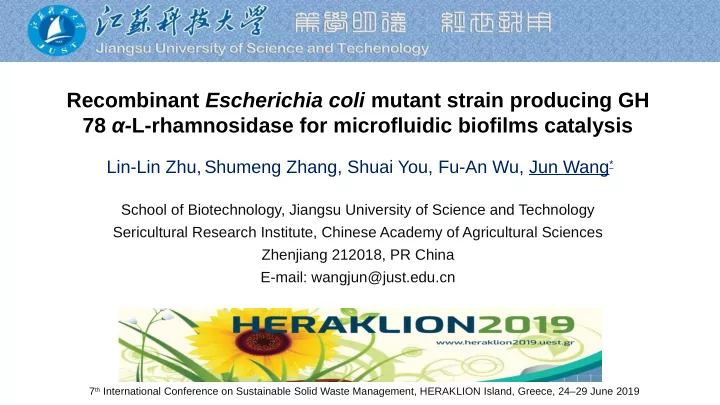

Recombinant Escherichia coli mutant strain producing GH 78 α- L-rhamnosidase for microfluidic biofilms catalysis Lin-Lin Zhu, Shumeng Zhang, Shuai You, Fu-An Wu, Jun Wang * School of Biotechnology, Jiangsu University of Science and Technology Sericultural Research Institute, Chinese Academy of Agricultural Sciences Zhenjiang 212018, PR China E-mail: wangjun@just.edu.cn 7 th International Conference on Sustainable Solid Waste Management, HERAKLION Island, Greece, 24–29 June 2019
CONTENT 04 02 Methods Conclusions 01 03 05 Introduction Results Acknowledgments 2
1. Introduction Waste resources Flavonoids sources Flavonoids Domestic waste 3
High-value product prepared by biocatalysis Isoquercitrin How to enhance production ? 4 [1] Junior A G , et al. J Ethnopharmacol, 2011, 134(2): 215 .
Biofilms as living catalysts Biofilms are resilient to a wide variety of environmental stresses. This inherited robustness has been exploited mainly for bioremediation. 5 [2] Halan B , et al. Trends in Biotechnology, 2012, 30(9): 453-465 .
Microfluidic biofilms catalysis technology Diluting Sampling Loading Fast reaction rate High recovery rate Recycling ability Detection Reaction Separation 6 [3] Vázquez-Villegas P, et al. Lab on A Chip, 2016, 16(14): 2662. [4] Qi L, et al. Analytical & Bioanalytical Chemistry, 2015, 407(13): 3617-3625 .
Microfluidic biocatalysis (Our 2.0 Edition) Microfluidic biofilms catalysis is going on------ 7 [5] Wang J*, et al. International Journal of Molecular Sciences. 2018, 19(9), 2590.
2. Methods Truncated geng rhaB1-ΔN Fluorescent protein gene EGFP rhaB1-ΔN-EGFP SDS-PAGE analysis Enzyme activity analysis Recombinant E. coli BL21-pET28a- rhaB1-ΔN-EGFP 6 The geng rhaB1 provided by Prof. Dr. Wolfgang Streit, UH, Germany
Self-made microreactors 9 PDMS microchip Microfluidic biofilm catalytic system
3. Results A new catalyst rhaB1-ΔN-EGFP D C Fig. 1 Expression of rhaB1-ΔN-EGFP. (A) Fragment of rhaB1-ΔN (2076 bp) and EGFP (720 bp) was amplified by PCR with template; (B) Recombinant plasmids was extracted from pET28a- rhaB1-ΔN-EGFP ; (C) Strain growth in a flask; (D) SDS-PAGE of rhaB1-ΔN-EGFP (103 kDa). (M) protein Maker, (1) induced expression of rhaB1-ΔN-EGFP, (2) Purified rhaB1-ΔN-EGFP, (3) BL21-pET28a. 10
Enzyme activity assays of rhaB1-ΔN-EGFP A B C Enzyme activity increased by 3U/mL 173 172,5 172 171,5 171 D E 170,5 170 169,5 Optimal conditions: 169 168,5 Temperature = 35 ℃ pH = 6.5 11 Fig. 2 Enzyme activity assays of rhaB1-ΔN-EGFP and rhaB1.
Isoquercitrin production catalyzed by rhaB1-ΔN-EGFP Table 1 Comparison of rhaB1 and rhaB1-ΔN-EGFP catalysts performance for rutin hydrolysis. Free enzyme Temperature ( ℃ ) pH Time (h) Yield (%) A B rhaB1 35 5.0 10 98.3±3.8 rhaB1-ΔN-EGFP 40 6.5 10 92.9±4.4 Fig. 3 Effect of pH and temperature on isoquercitrin yield 10
Construction and formation of microfluidic biofilms A B Fig. 4 Construction and formation of microfluidic biofilm. (A) Culture method; (B) Surface chemically modification. 11
Culture parameters of microfluidic biofilms A B Optimal pH = 7.0 , flow rate = 8 μ L/min Fig. 5 Effects of different flow rates and pH on the growth of biofilm. (A) pH; (B) Flow rate. 12
Characterization of microfluidic biofilms by LSCM A B C D E Fig. 6 Laser scanning confocal microscopy observation of bacterial biofilm growth in microchannels. (A) adsorption growth for 2 h; (B) single channel culture for 24 h; (C) single channel culture for 48 h; (D) sectional flow culture for 24 h; (E) Growth chart of 48 h in subsection flow culture. 13
Catalytic process of microfluidic biofilms 0.79 μ g/L tube /d A B C C B Fig 8 Efgect of temperature (A), pH (B) and rutin concentration (C) on the isoquercitrin productivity and rutin conversion in the microfmuidicbiofjlm reactor Rutin concentration 0.6 pH 6.5 Temperature 35 ℃ g/L 15
4. Conclusions 1. The recombinant strain BL21-pET28a- rhaB1-ΔN-EGFP was successfully constructed and produced a new enzyme rhaB1-ΔN-EGFP. 2. rhaB1-ΔN-EGFP showed 95% relative activity after treatment for 60 min at the optimum temperature of 35 ℃ , showing good thermal stability. 3. Using free enzyme rhaB1-ΔN-EGFP to catalysis the hydrolysis of rutin, the optimum temperature and pH value were 40 ℃ and 6.5, and the maximum yield of isoquercitrin was 92.9±4.4%. 4. The fluorescence intensity of the biofilm increased by 74% after 24 hours under segmental flow, and the biofilms exhibited compact and flat characteristics under the fluid force. 5. The yield of isoquercitrin reached 0.79 μ g/L tube /d when the substrate rutin concentration was 0.6 g/L, the reaction temperature was 35 ℃ , and the pH was 6.5. 16
Acknowledgments We are grateful to Collaborators: Prof. Dr. Wolfgang Streit, UH, Germany Dr. Ulrich Rabausch, UH, Germany Group students: Linlin Zhu, JUST, China Shumeng, Zhang, JUST, China Fundings: • National Natural Science Foundation of China (grants 21676130 and 21705059) • Key Project of University Science Research of Jiangsu Province (grant 16KJA530002) • Six T alent Peaks Project of Jiangsu Province (grant 2015-NY-018) • 333 High-level T alent T raining Project of Jiangsu Province (Year 2018) • Shen Lan Young Scholars Program of Jiangsu University of Science and T echnology (Year 2015) • Postgraduate Research & Practice Innovation Program of Jiangsu Province (SJKY19_2670) 17
Thank you very much for your kind attention! Jinshan Temple Please feel free to ask any questions… (1600 years old) Zhenjiang City 7 th International Conference on Sustainable Solid Waste Management, HERAKLION Island, Greece, 24–29 June 2019
Recommend
More recommend